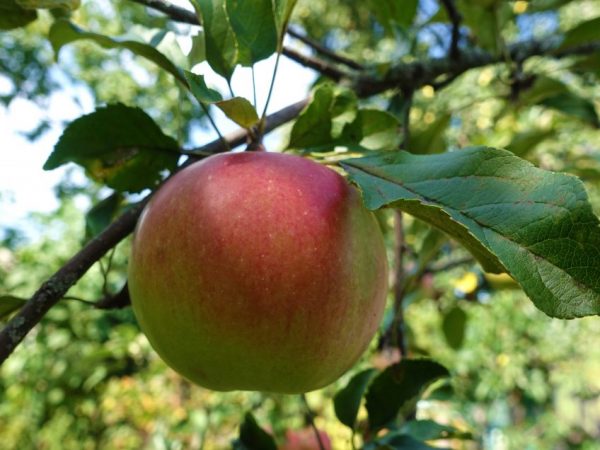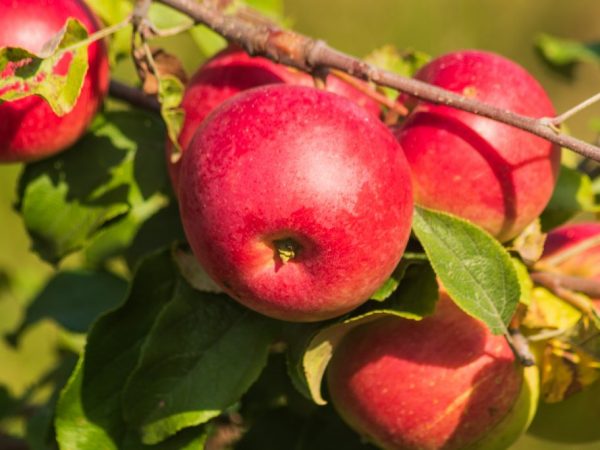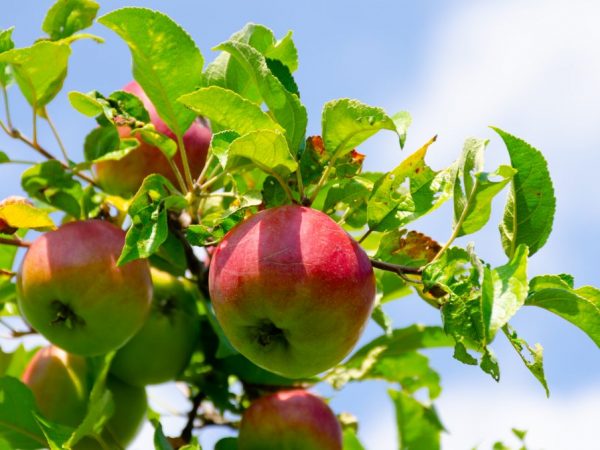Features of the Welsey apple tree
Thanks to the breeders, many interesting winter-hardy varieties of apple trees have been bred, which have unique qualities. Among the ten best hybrids is the Welsey apple tree. This culture is appreciated for its high yield, ease of maintenance and excellent taste of the fruit. It is grown throughout Russia.

Features of the Welsey apple tree
Characteristics of the variety
Many gardeners are familiar with the Welsey hybrid form - this culture is highly decorative and is a real decoration of the garden.
Wood
At the initial stage of growth, the tree has a pyramidal shape; closer to mature age, the crown becomes spherical.
The Welsey apple tree is large-sized, the branches are slightly drooping, brown in color, with slight pubescence. Its height is 5-5.5 m. The leaves are dark green, lanceolate, with wavy edges.
It blooms in pale pink shades, blooms in mid-July.
The type of fruiting is mixed: ovaries can form on fruit branches, ringlets, spears.
Fruit
Wellsie apples are medium in size, crimson in color, some are deep red or yellow-green with a red blush. Fruits are round or oblong in shape, the average weight is 150-170 g.
The skin is thin, the flesh is sweet with a slight sourness, juicy. Therefore, the fruit of the fruit tree is of great value among consumers.
The harvest time is influenced by the climatic conditions of the region. Mostly apples ripen from the second decade of September to the first half of October.
Pollinators
According to the description, the culture is partially self-fertile - without the neighborhood of pollinating trees, it sharply reduces the yield.
The following varieties are suitable: Antonovka, Autumn striped, Zvezdochka, Borovinka, Macintosh.
Growing regions
This zoned variety is intended for both industrial and private gardening. The most widespread was on the territory of the European part of our country. The most favorable regions are Tula, Orel, Bryansk, Pskov and Central Black Sea.
This crop is successfully cultivated in the regions of the Central strip and the Moscow region, in some regions of Siberia and the Altai Territory. The variety has become widespread in Belarus and the Baltic countries.
Fruiting

The variety has good fruiting
The increase in yield occurs gradually - in the first years of fruiting, the tree gives about 30 kg of fruit, after 2 years this figure reaches 45 kg, and by 10-12 years from one apple tree you can remove from 200 to 250 kg of juicy and tasty fruits.
Record rates were recorded in the Krasnodar Territory - 280 kg per plant aged 16 years. With a slight load of fruit ovaries, fruits ripen small. To obtain large fruits, the fruit ovaries are normalized.
According to gardeners, with age, the crop does not reduce the amount of harvest.Even on the poorest soil, the plant bears fruit successfully.
The fruits of this variety are universal - they are consumed fresh and used for processing (making juices, compotes, pastilles, jam).
Ripening and storage of crops
Harvesting takes place from mid-September to mid-October.
The apples are picked in several passes - ripe fruits are picked, and the unripe ones are left on the tree to ripen.
They are placed in cardboard boxes or wooden boxes, shifting each layer with paper. The optimum storage temperature is 0 °.
The best place to preserve the harvest will be a cellar or basement. In conditions of low humidity, the fruits deteriorate faster - they begin to wrinkle and wilt. The optimum humidity level is 60-70%.
In industrial horticulture, the harvested fruits are placed in a special storage facility equipped with a special refrigeration unit. In such conditions, the crop can lie until February without losing its taste and marketability.
Benefits of the variety
- Early maturity - the plant begins to give its first fruits already in the fourth year of planting.
- It has a consistently high yield.
- Average winter hardiness. Withstands lowering up to 25 ° (at lower temperatures there is a high risk of freezing of flower buds and fruit branches).
- Scab resistance is high, which is one of the valuable qualities of the tree and allows you to preserve the harvest and its commercial qualities, taste.
- Good keeping quality of fruits after harvest - until the second decade of January.
- High marketability and excellent taste of the fruit.
- Possesses good long distance transportability.
- No need to ripen the crop after harvest.
Disadvantages:
- the tendency of fruits to early shedding;
- the variability of the taste of fruits, which is caused by the weather and climatic conditions of the region (in the rainy season, the fruits have a less intense taste and aroma).
Growing features

Trees must be protected from drafts
Planting of seedlings is carried out in the spring before bud break.
For cultivation, choose a flat area in the garden with a deep passage of groundwater (no closer than two meters to the soil surface). An area protected from winds and drafts is suitable for planting.
A soil with a neutral acidity level with good moisture and air permeability is suitable for this variety. Sandy loam soil, slightly acidic chernozem or gray forest soil are best suited.
Before planting, nutrients are introduced into the soil: rotted manure or humus (5-6 kg), wood ash - 0.5 kg and nitroammofosk - 15 g.
Landing rules
The digging of planting holes is carried out a week before the planned planting of seedlings. Young plants do not have too large a root system, so holes 80 cm deep and 70 cm wide are dug for planting them.
The bottom of the pit is filled with pieces of broken brick, expanded clay or pebbles to provide a good drainage layer. Then a mixture of peat and humus, mixed in equal quantities, is poured upstairs - 1 bucket.
Landing technique:
- the landing pit is spilled abundantly with water (2-3 buckets);
- then the roots are lowered and straightened;
- seedlings are sprinkled with soil and trampled down well in the area of the trunk circle;
- after planting trees are watered - 2 buckets of water per tree.
The planted trees are mulched with a thick layer of peat to prevent moisture evaporation. Humus or peat is used as mulch.
After planting, a metal or wooden peg is driven in near each plant to provide young trees with resistance from the winds.
Care requirements
Basic care of the Welsey apple tree:
- Regular watering. In the first years of life, the tree should be watered frequently throughout the season and especially during dry summers. 1-2 buckets of water are poured under one seedling once a week. In the rainy season, the frequency of watering is reduced to 1 time per month.The apple orchard experiences a special need for moisture during the flowering period, the formation of fruit ovaries and the pouring of fruits. From a lack of moisture, apples will ripen not so juicy and large.
- The soil in the area of the trunk circle must be loosened to eliminate the risk of crust formation on the surface, which does not allow moisture and oxygen to penetrate to the roots.
- After loosening, a mulching procedure is carried out - rotted manure or peat is introduced into the zone of the trunk circle. These components provide additional nutrition for the seedlings and prevent the soil from drying out.
- Weed control is a must for basic care. They are regularly removed as they grow so that they do not choke the young trees and take away nutrients from them.
- The Welsey variety responds well to feeding, the first feeding of seedlings is carried out in the spring - 1 tbsp is applied under each apple tree. l. nitroammophos. During the formation of flower buds, potassium salt and superphosphate are introduced - 20 g of each component. With the onset of autumn, trees are fertilized with wood ash - 0.5 kg of a substance is added under each tree.
- The apple orchard is pruned 2 years after the young trees are planted. In the spring, a sanitary haircut is carried out, which involves the removal of all shrunken, broken off and damaged branches. All branches growing inside the crown are also cut out.
All cuts are treated with garden pitch. Saplings that do not have side shoots should be pruned immediately after planting - their height is shortened by 60 cm from the ground surface. This will stimulate the growth of skeletal branches.
Pests

Caterpillars can harm the apple tree
The most vicious parasite is the moth caterpillar, which spoils most of the harvest by gnawing the passages in the fruit pulp. To do this, trapping belts, toxic to insects, are installed on the trees. Additionally, the apple tree is treated with chlorophos: 20 g per bucket of water.
The second parasite that causes colossal harm is the hawthorn. The butterfly lays eggs, from which motley caterpillars hatch later. They eat away young foliage, flower buds and ovaries. In the fight against parasites, chlorophos is used in the same concentration as for the destruction of the moth.
For prevention purposes, it is necessary to keep the site clean - to remove and burn fallen leaves, plant residues, weeds in time.
Diseases
In addition to parasites, the apple tree is annoyed by diseases that appear during damp and rainy weather, as well as due to illiterate care:
Powdery mildew
First, the leaves and shoots are covered with a whitish bloom, similar to flour. Then the leaves curl up, dry out, crumble, and the shoots are covered with a black bloom.
At the first symptoms, the crown of the tree should be treated with a solution of colloidal sulfur (2%): 20 g per 10 liters of water.
The second processing of trees is carried out immediately after they have faded. This time a 1% colloidal sulfur solution is used.
The third spraying is carried out two weeks after the second.
Topaz is another effective remedy for fungal infections.
Cytosporosis
The peak of the development of the disease occurs in the summer.
Signs of damage: inflorescences and leaves dry out, but do not crumble. The bark of trees is covered with a brownish-red bloom and contains small swellings in the form of bubbles.
Treatment consists of several stages.
- First, the affected areas are cleaned on the tree, treated with a solution of copper sulfate (30 g of the substance is dissolved in 1 liter of water).
- A couple of hours after that, the treated areas are smeared with garden varnish.
It can be cured only at the initial stage, when the form is neglected, the tree dies and any control measures are already useless.
Subspecies
In nurseries of our country, this variety is found under a different name: Izobilnoe, Fertile, Tarutskoe rose, Urozhainoe and Tartus rose.
In some regions, the creeping form of the Welsey variety can be found - it is a winter-hardy, early-growing apple tree with high disease (and scab) resistance.
Up to 12 kg of bright red fruits with a delicate and sweet cream-colored pulp can be removed from one tree.
Gardeners reviews
Almost everyone who is engaged in the cultivation of this apple variety is satisfied.
Thanks to its unpretentious care, scab resistance, growing yields and excellent fruit taste, the Welsey apple variety has gained great popularity among gardeners in our country.
Using the growing technique described above, you can easily grow this tree on your site and enjoy its tasty, healthy and fragrant harvest every year.

